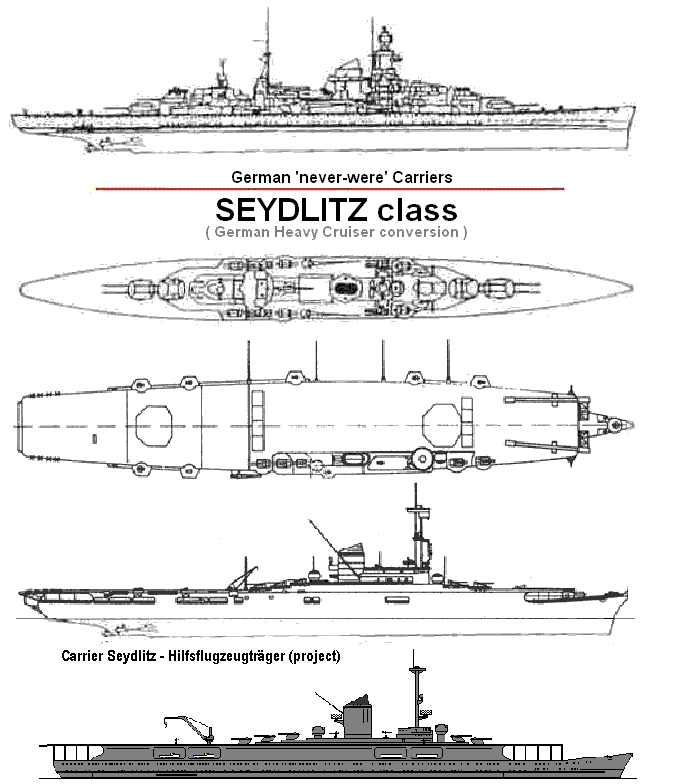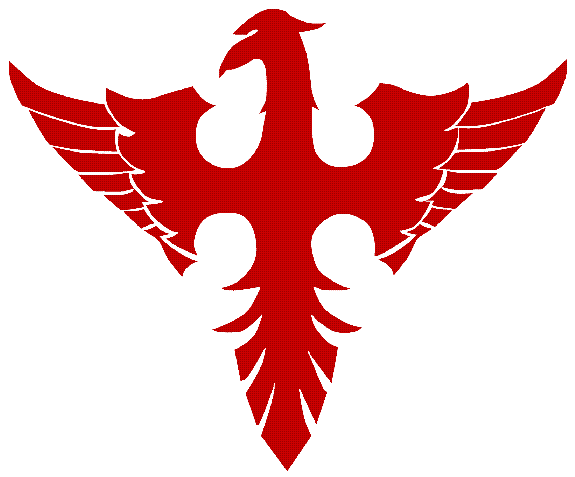From the end of the 1940 war year on, German naval leadership concerned itself-at least partially as a result of the successful British carrier-plane attack on the Italian fleet at Tarento with considerations as to how to remedy the lack of aircraft carriers most quickly. 
Kreigsmarine Aircraft Carriers - Seydlitz Class ==========================================================================

A series of five cruisers and merchant ships were planned for conversion starting 5/1942 as an effort to provide a practical naval aviation force. None of the ships was ever completed as a carrier, and most conversions were never started. All were cancelled late in 1942 or early in 1943, when the carrier programs were cancelled. These were not sisterships, but are listed together for convenience. These vessels are commonly identified by their original names; new names had not been assigned prior to cancellation of the conversions.
Generally similar to GRAF ZEPPELIN. The conversion would have involved removal of existing superstructure and construction of a new flight deck, hangar, large island, and a heavy defensive battery. Details varied among the ships.
Subjects under discussion concerned not only the reconstruction of existing large warships, but also the adaptation of merchant ships, insofar as they seemed suitable in terms of size and speed. Included in these considerations were the battleships SCHARNHORST and GNEISENAU, as well as the heavy cruisers LUTZOW (a re-named pocket battleship formerly known as the "Deutschland") and ADMIRAL SCHEER on the one hand, and the passenger ships EUROPA and POTSDAM of the North German Lloyd line on the other.
The passenger ships were the only ones that met the basic requirements: the EUROPA was the largest, since the loss of the BREMEN to fire, weighing nearly 50,000 tons, and had a suitable top speed of 27 knots, while the POTSDAM, of only about 18,000 tons and a speed of 21 knots, were somewhat less well-suited though still usable. In addition, the rebuilding of the heavy cruiser SEYDLITZ, about 90% finished, seemed feasible, as opposed to converting the battleships of the SCHARNHORST class and the heavy cruisers LUTZOW and ADMIRAL SCHEER, which were then dropped from these considerations.
The creation of aircraft carriers was one of the main points in the Commander of the Navy's report to Hitler at the latter's headquarters on May 13, 1942. Thereupon Hitler decided that the EUROPA and POTSDAM should be rebuilt into auxiliary carriers. In a further report taking place on August 26, 1942 a further possibility was suggested: this involved the French cruiser DE GRASSE, lying on the slipway in Lorient, of which the rebuilding into an aircraft carrier seemed feasible.
The rebuilding plans for these ships were begun at once. In the process it was learned that the task had obviously been strongly underestimated and the difficulties that would necessarily arise in the construction of these ships, intended as they were for fully different purposes, had gone unrecognized. It was chiefly their form and weight stability and their inner division that were insufficient. It was believed that these problems could be mastered by applying a thick "armor plate" of heavy cement and building on side bulges, but this could not be achieved in a really satisfactory way and, in addition, brought about a limitation of their speed, which was not that great to begin with. The EUROPA-now designated "Auxiliary Aircraft Carrier I"-was to be rebuilt by Blohm & Voss in Hamburg-her builders-but this did not transpire: as early as November 25, 1942 the work of planning was halted and the rebuilding was cancelled even before the work had begun. The reason for this was the lack of stability even with the bulges built on, the problem of rigidity caused by the lowering of the hangar deck into the main formation deck, which could not be done any other way, and finally the expected very high fuel consumption when the ship was in use again.
The rebuilding of the other passenger ships was to be entrusted to the naval shipyards at the Howaldt Works of Hamburg , but with the cancellation of the rebuilding of the EUROPA, the contract for the POTSDAM was transferred to Blohm & Voss in November of 1942. With them too, problems of a very similar kind arose, especially in terms of stability, which were addressed with the same means-building on bulges and applying heavy concrete "armor plate".
According to a decision made on the same day, this was to be set up as a training aircraft carrier. The work actually began that December: in Kiel they began to remove the passenger cabins. In the midst of this work, it all came to an abrupt end on the basis of the aforementioned "Fuehrer’s Command."
The work of planning for the conversion of the uncompleted French heavy cruiser DE GRASSE, which began in April of 1942 under the designation "Auxiliary Aircraft Carrier II", led to this project being given up, as it was shown to be too expensive in terms of work and materials, was under ever· increasing danger of air attack, and finally, second thoughts about what from the German standpoint was an unsatisfactorily divided power system could not be allayed. At the beginning of February 1943 the planning work was halted.
After the spring of 1943 the navy had no possibility of any realizable construction of aircraft carriers.

Project Weser - German Heavy Cruiser Seydlitz
Seydlitz was under construction before the war and was to be the fourth ship in the Admiral Hipper class heavy cruisers. She had the same design as Prinz Eugen and was laid down in Bremen in early 1937 by Deschimag & Company. On 19 January 1939, the finished hull of Seydlitz slid into water. Work progressed and the new "Atlantic bow" was refitted in July. When war broke out, Grand Admiral Erich Raeder canceled all Z-Plan ships in progress, and the work on the heavy cruisers Seydlitz and KMS Lützow was halted. Seydlitz was about 66.5% complete. Quite likely all the 8-inch turrets were finished, if not also the 8-inch guns. The vessel would have been completed in January 1941.
Heavy cruisers of the Admiral Hipper Class were products of Germany's race to rearm in the late 1930's and, for their tiime, were some of the world's most formidable and revolutionary warships.
Three ships of the class, Hipper, Blücher and Prinz Eugen, saw service for Germany in World War II. Hipper was damaged in an attack on a convoy on New Year's Eve 1942 and remained out of service until January 1945; she was scuttled at Kiel Deutsche Werke shipyards on 2 May 1945. Blücher was sunk in Oslofjord during the German invasion of Norway. Prinz Eugen survived the war and she sank at Kwajalein Atoll on 22 December 1946 after atomic weapons tests.
A fourth, the Lutzow, was sold to the Soviet Union in 1939 before completion (and the name re-assigned to the Deutschland) where she served the Russians as first the Petropavlovsk and then the Tallinn in the Baltic; she was scrapped in 1950.
A fifth, the Seydlitz, was to be converted into an aircraft carrier; but this project was not completed and she was scuttled at Königsberg in April 1945.

Sister ship to the Admiral Hipper (all-gun), Seydlitz looked similar in profile except for the flight deck and lack of rear turrets. Her superstructure, however, was offset to the starboard side. Not built to fight other warships, Seydlitz was to be a lone commerce raider or a fleet scout with her four radar-directed heavy guns and Arado 196T scout-bombers that carried a single 250 kg bomb or depth charge apiece. One new feature was the "Knickebein" beam navigation system to guide her aircraft back to her. Another was a new accellerator/catapult that used twin 1,000+ hp airplane engines hooked up to a torque converter connected to a deck shuttle. Like putting your foot on the brake as you step on the gas pedal of an automatic transmission-equipped automobile, the wind-up energy builds and then is transmitted as soon as you release the brake. This technique was put to good use post-war as the Buick "Dynaflow" transmission. Though hailed as a marvel when designed, Seydlitz was an interim design. The plethora of new full-sized aircraft carriers being built in the late '30's by Germany's potential enemies meant that the lone raider's days were numbered.
Like her sister the Lützow, she was considered for sale to the USSR but Hitler would not allow this. Work continued on her at a slow pace but by May 1942, she was near completion as a cruiser.
Following KMS Tirpitz's narrow escape from British carrier-based aircarft in March 1942, the need for maritime fighter cover for capital ships was realized. It was decided to resume work on the aircraft carrier KMS Graf Zeppelin, and to convert Seydlitz into a carrier (under the project name of Weser 1).
In Bremen, work began to dismantle the superstructure of the would-be cruiser. Probably the armament had already been removed to the Atlantic Wall or the Norwegian coastal defenses. Some time around November or December 1942, all remaining superstructure was removed, but the project moved slowly and the CVL Seydlitz was never completed. It may have looked like a mini Graf Zeppelin with a pole mast conning tower, a curved smokestack, and some AA guns on deck on the starboard side, but no medium or heavy turrets. Seydlitz was stripped down to deck level before heavy bombing of the near-by U-Boat facilities forced her to move to Königsberg (via Kiel).
In the few months Seydlitz spent at Königsberg, not much work towards becoming an aircraft carrier could have been done; only some basic flight deck support construction had begun.
On New Year's Eve the Battle of the Barents Sea took place, in which a superior German naval force was turned away by British light cruisers and destroyers. Hitler was furious and ordered all capital ships decommissioned and all works in progress abandoned.
No more work were ever done on Seydlitz. From this point on, Seydlitz was not touched, the ship being rated as a hulk and was used only for her crew accommodations by the end of 1944. She remained in the Schichau Yards in Königsberg until the Russians arrived in April 1945, when she was was scuttled at her berth to prevent capture by the Red Army.
Now in Soviet hands, she was raised in early1946 by the Baltic Fleet and renamed Poltava with plans to rebuild her. Although some believe she never left the Schichau yards at Königsberg, there is a report that the hulk may have been towed to Leningrad around October 1946, having being spotted in transit by RAF photoreconnaissance aircraft. This may have some bearing, as she could well have been used as a spares source for the Lützow. There are no solid dates available, but she is believed to have been scrapped.

=================================================================================
NB: The above text has been collected / excerpted / edited / mangled / tangled / re-compiled / etc ... from the following online sources :
KM - German Auxiliary Fleet Carrier Program - http://www.hazegray.org
KM - German Auxiliary Fleet Carrier Program - h863.org
KM - German Heavy Cruiser Seydlitz - /www.battleships-cruisers.co.uk
KM - Seydlitz (Heavy Cruiser) - http://www.geocities.com article #1
KM - Seydlitz (Aircraft Carrier) - http://www.geocities.com article #2
KM - Cruiser (Hull) Seydlitz - wikipedia article #1
KM - Cruiser Admiral Hipper - wikipedia article #2
KM - Cruiser Admiral Hipper - wikipedia article #3
KM - Cruiser Admiral Hipper - www.battleships-cruisers.co.uk


